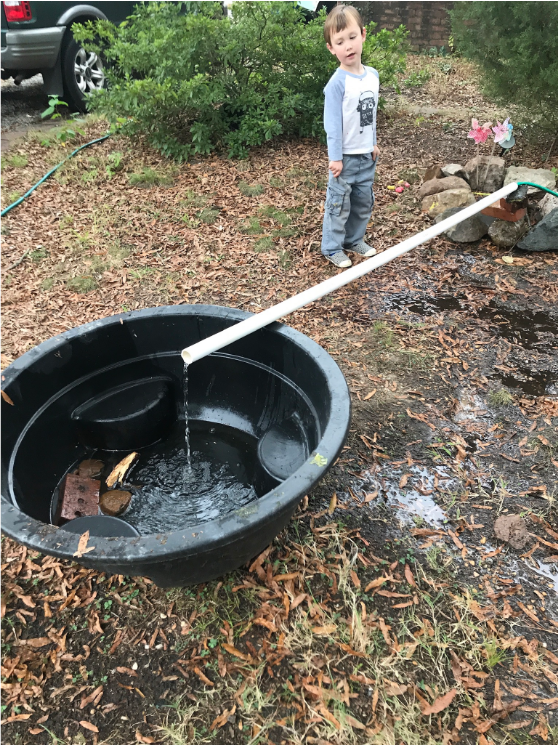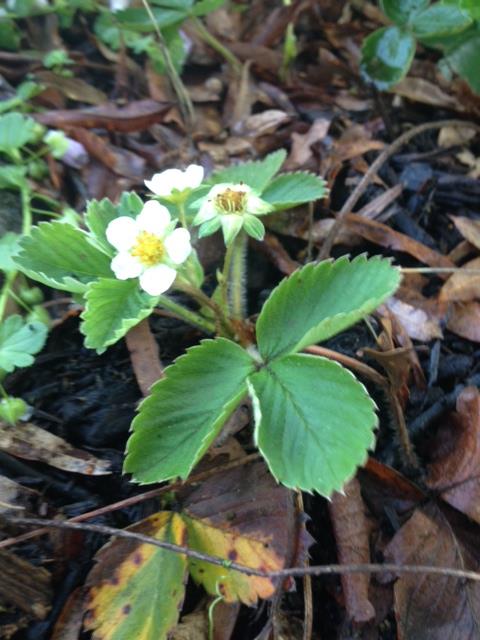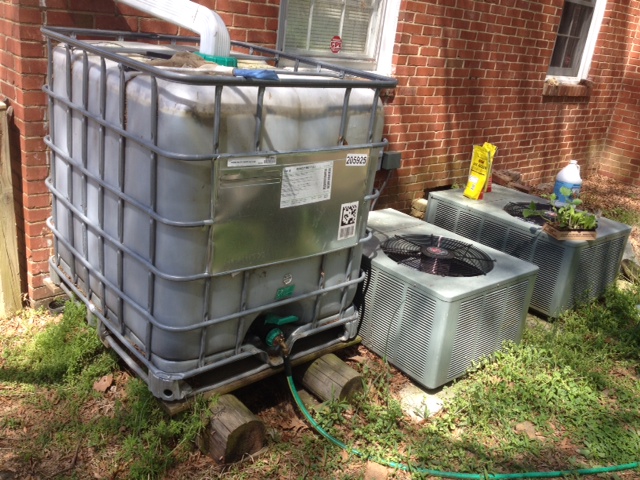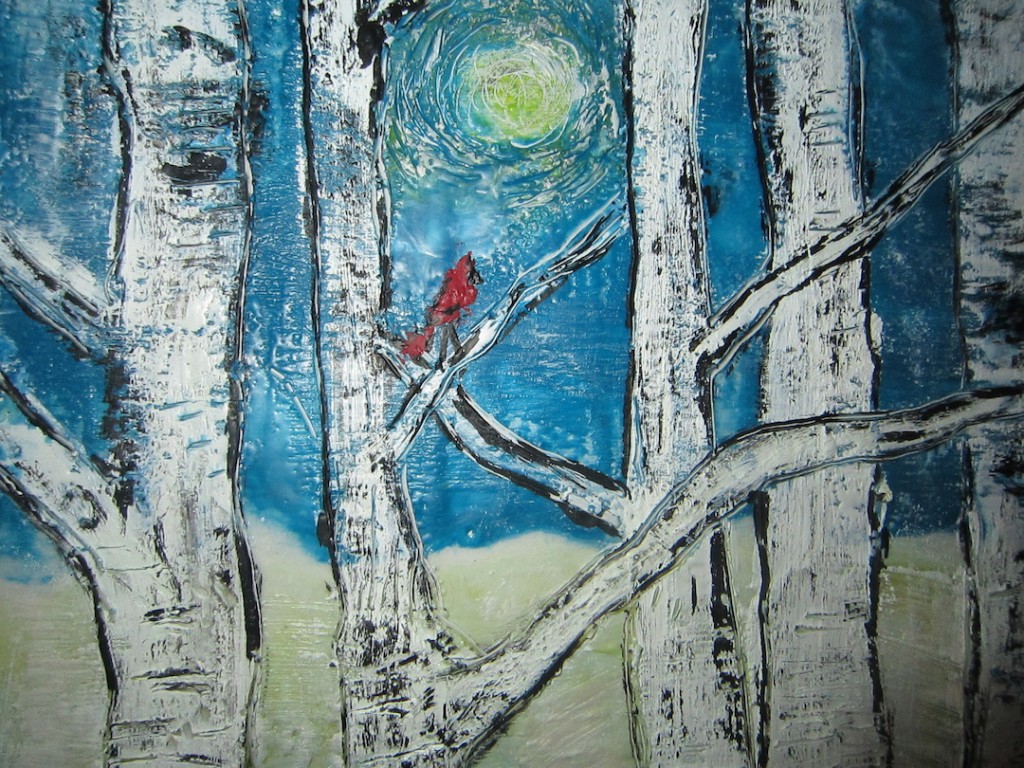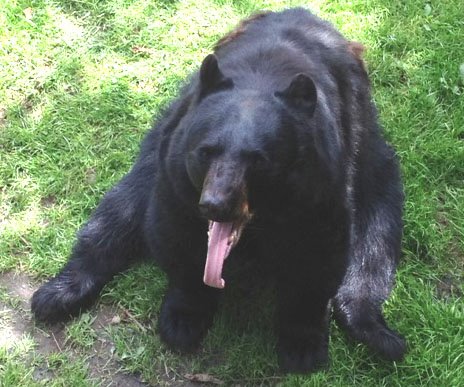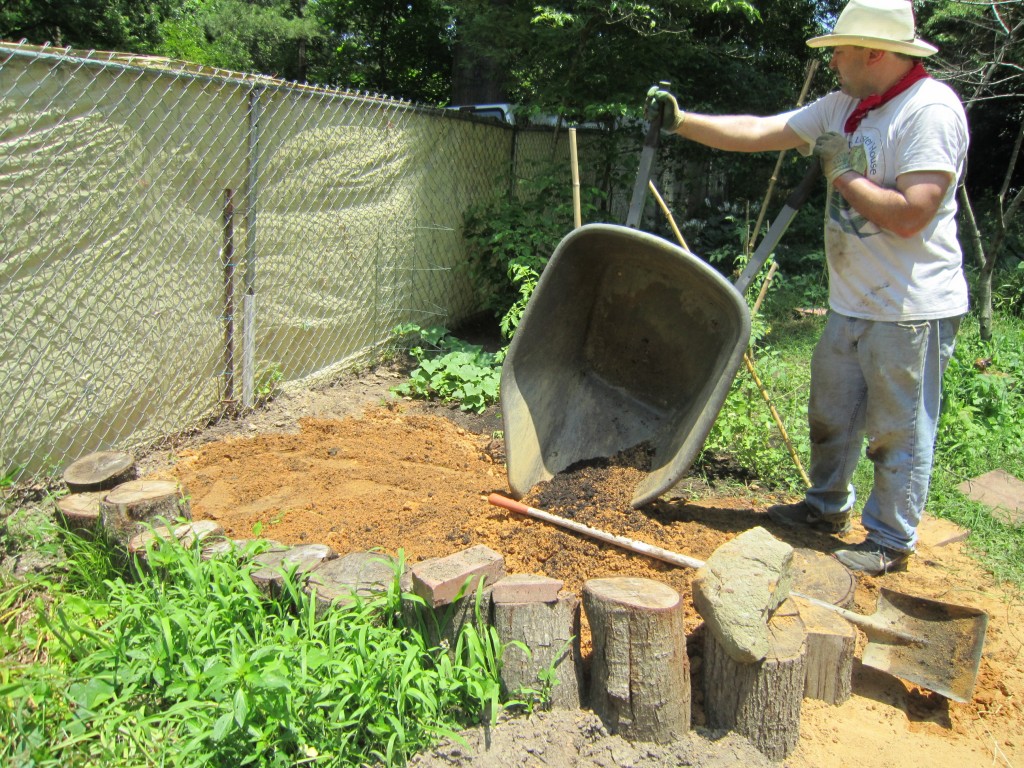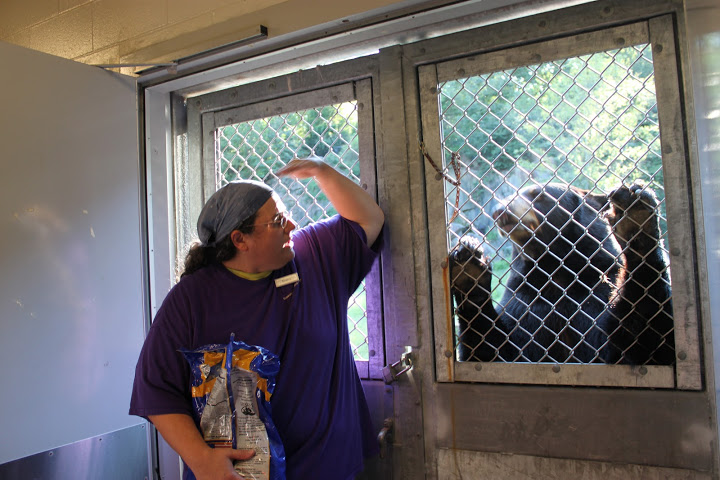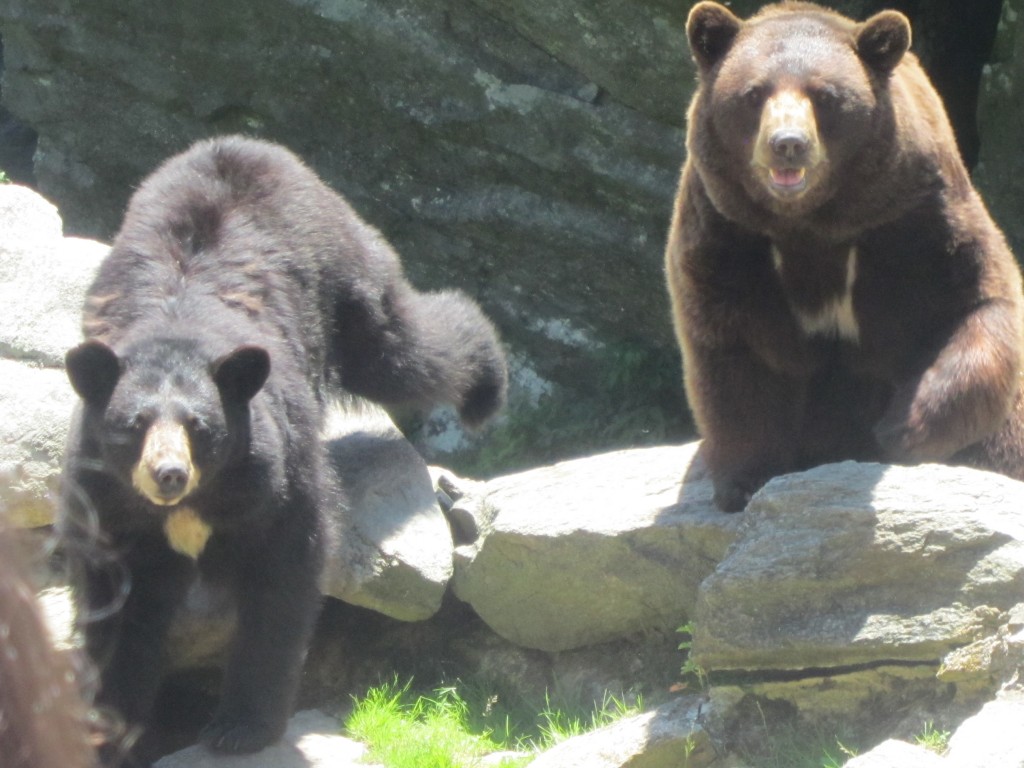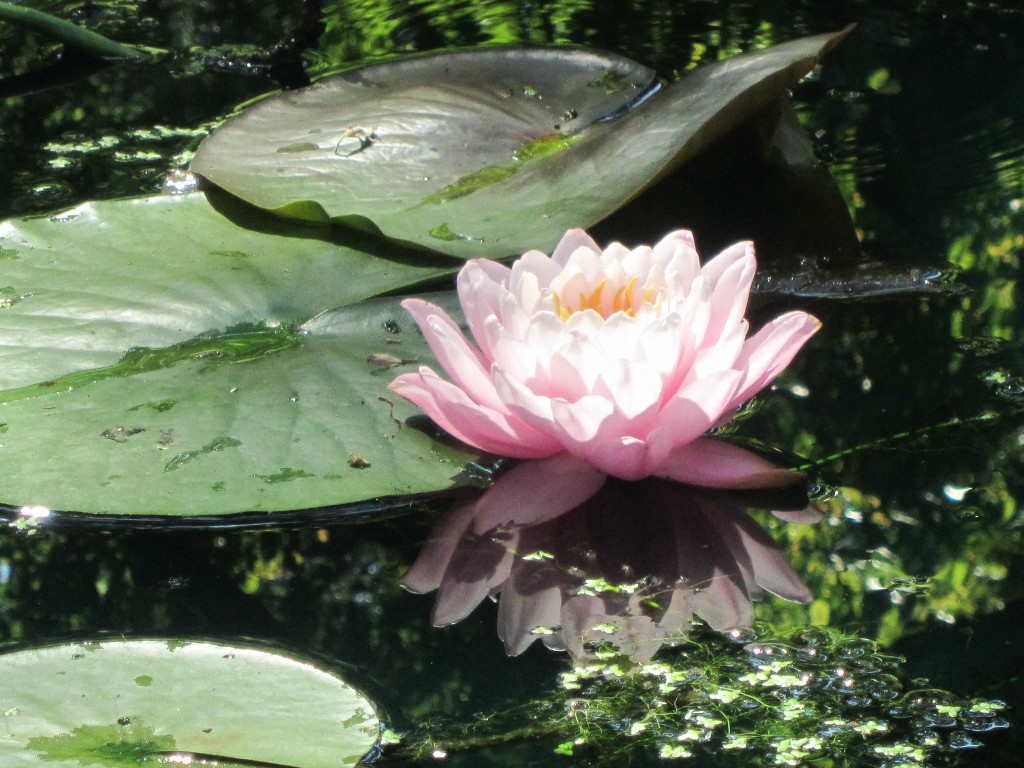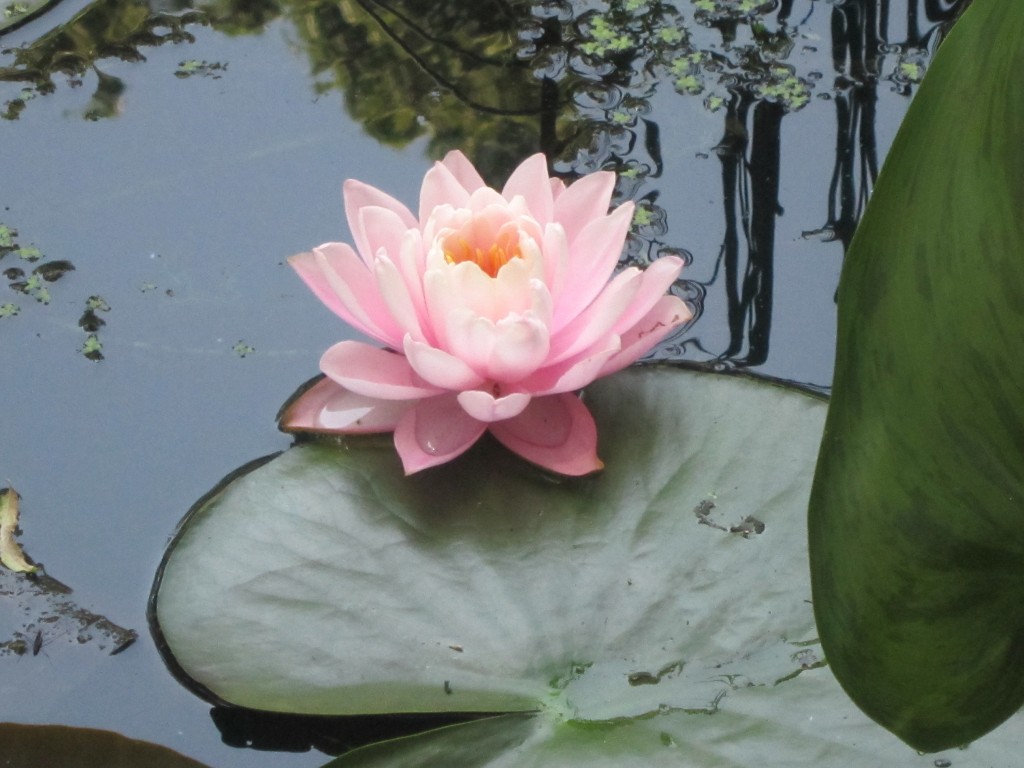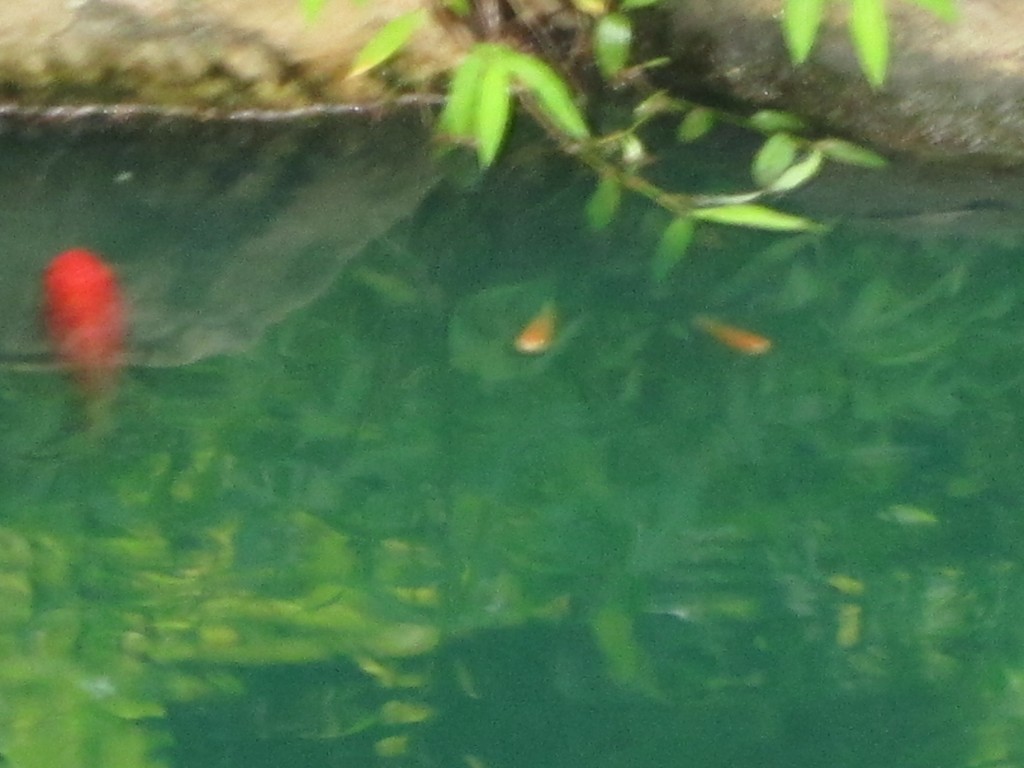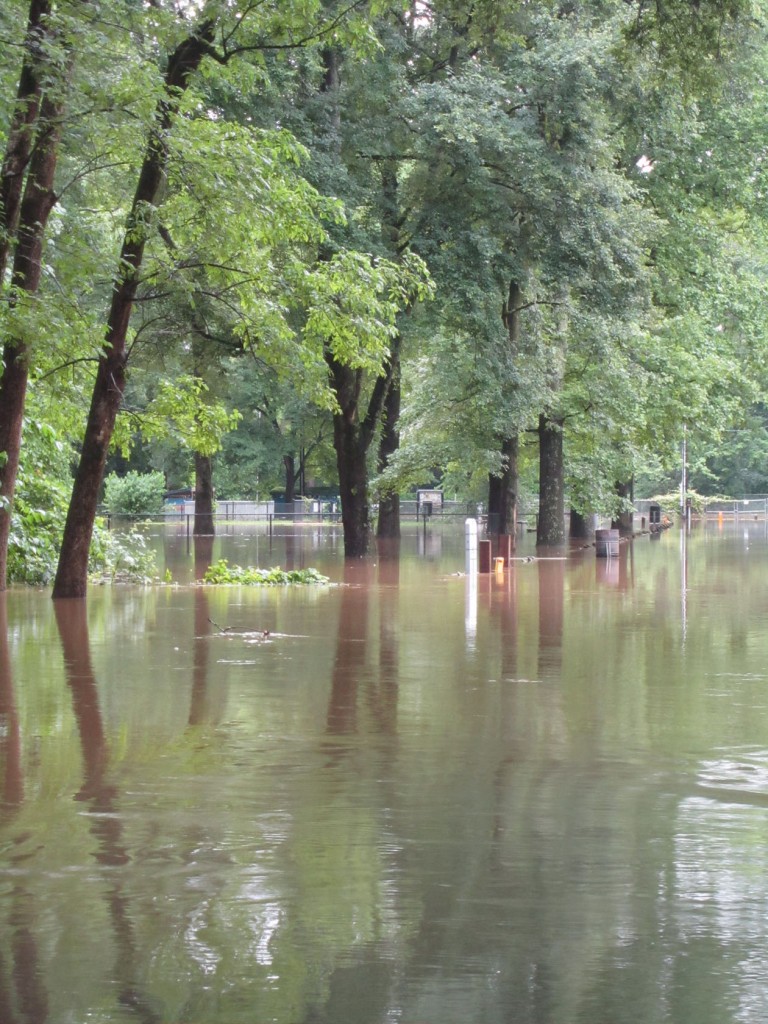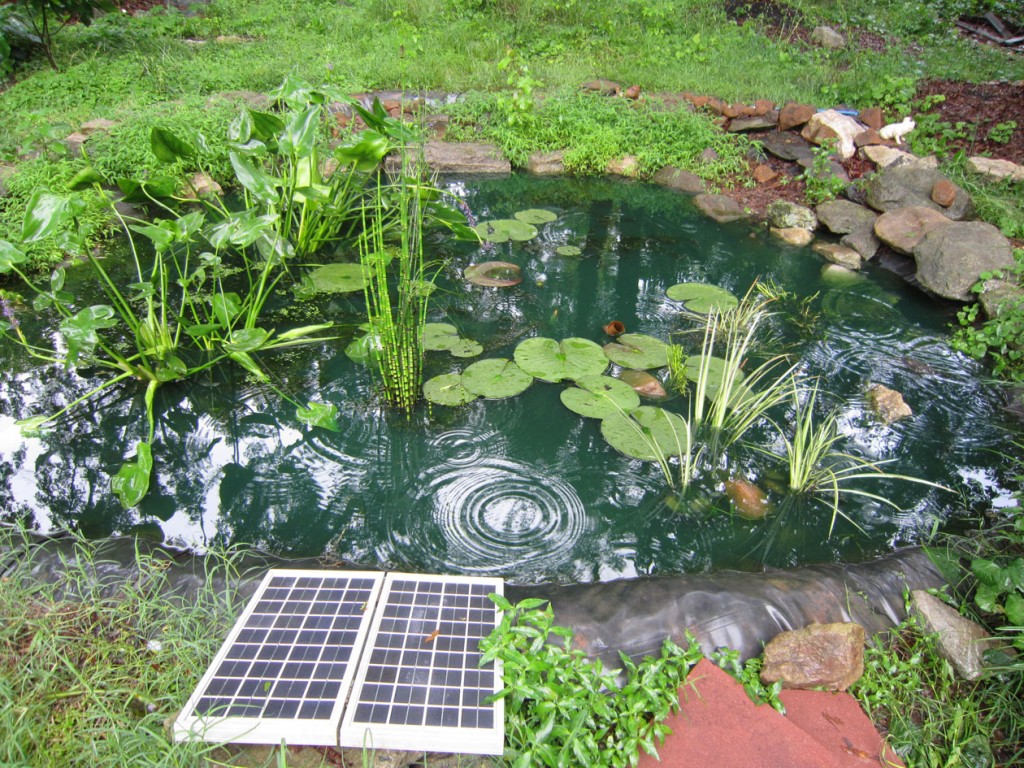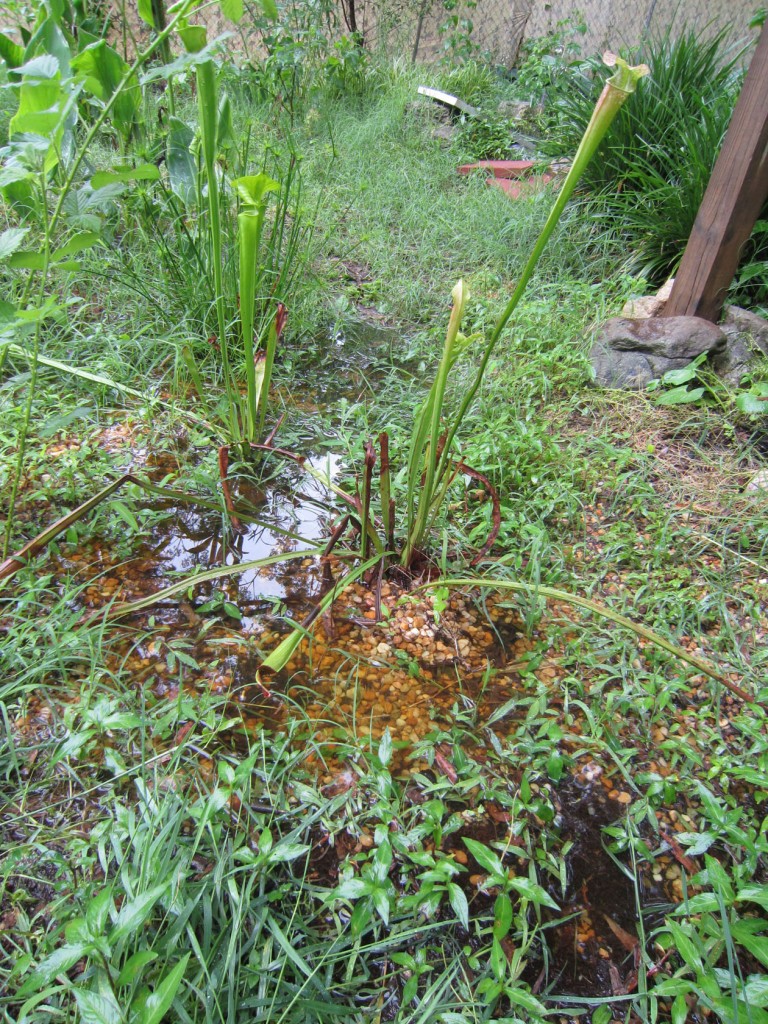Home » Uncategorized
Category Archives: Uncategorized
Spring
It’s April and the back of the yard is full of flowers. Yellow daffodils, purple comfrey and the beautiful white bell-shaped flowers on Solomon’s Seal make for a nice mix of spring colors.
The pitcher plants are thriving and making little ones.
The yard is teeming with life. L. and I have been doing a lot of digging in the backyard and occasionally we will leave a worm or two on top of the bluebird house. The babies fledged over the weekend.
The frogs have multiplied and made themselves at home.
Where there are frogs, there are herons. Last week I pulled open the curtains around 7 a.m. and there was the biggest heron I’d ever seen, beak in the water looking for his frog fix.
I lifted L. up on the kitchen counter to take a better look. We watched as the heron raised is head up out of the water, front feathers blowing gently in the breeze. He looked right at us, stood up and flapped his enormous wings. Next
thing we knew, he slowly lifted himself up from the pond and flew right towards
our window. He got so close to the window we could see the inside of his mouth, which was open. Then suddenly he swooped up and over the house and out of sight.
Our turtle, Mr. Fast, has risen up from the muck of the pond to make daily appearances. He has grown over the winter.
We have our own little wildlife habitat now!
Dinosaur Plants
It was a long, wet winter but eventually the sun came out. The yard is squishy in spots, but it has never looked more fecund. Clover, chickweed, moss, daffodils and other flowers dot the yard now. The blueberries are budding. I saw my first frog of the year hop into Farthing pond today.
The pitcher plants survived the winter but some have turned bright red.

Since last year we’ve expanded our bog, which is part of an overflow area from Farthing Pond. That means more mixing of peat and sand.

We built a smaller, T-shaped pond and connected it with the bog area Levi calls “Mielke Creek.” We have a surfeit of rocks and are thinking about things like building a set of stairs around the pond and a bridge across the bog.

We went over to Uncle Darren’s and got a bunch of horsetail plants a few days ago. They are a very aggressive plant and Darren had plenty to thin out. I took a bunch back to our place but put the plants in pots so they wouldn’t spread everywhere.
My goal with the horsetail (or scouring rush) was to use it to bring more dragonflies to our yard. They love to perch on them. Not that we’ve had any problem seeing any dragonflies—they love our pond and I’ve seen a number of different species, with different colors. But you can never have too many to help keep the mosquitoes at bay. Mosquito eggs are a favorite dish of theirs.
Horestail have been around for almost 350 million years ago, when Durham was near the equator and Pangea hadn’t started busting at the seams.
The dinosaurs loved to eat them, I told Levi. A resilient plant, it could take chomps from a dinosaur because the rhizome would stay intact underground.
It also reproduces with spores, like ferns.
The Turtle
I went outside to feed the cats the other evening and saw a large turtle hanging out near the pitcher plants next to the pond. Amazed, I ran back in the house and grabbed Shawnna and Levi. When we got back outside the turtle was heading towards the deep end of the pond and we watched him plop right in.
He’s decided to stick around. Every now and then we will walk near the pond and see him gliding about 6 inches under the surface. It never ceases to amaze me. Levi has named the turtle “Mr. Fast.”
I think about the line If you build it they will come. We recently expanded the wetland area in our backyard with the construction of “Mielke Creek,” which started out as an overflow area in front of the pond. The frogs (and now Mr. Fast) seem to love it.
We connected the trench to our peat bog with the pitcher plants.
Currently we are working on constructing a bridge across Mielke Creek. We’ve spent hours of fun playing in the water and mud, moving rocks and dirt.
The Fledglings
Our bluebird babies are getting ready to fledge. Last night a whole family of bluebirds flew into our backyard and perched themselves in a tree high above the bluebird house. The fledglings were poking their heads out, unsure of their next move. while our feral cat Grace was looking up at the scene, licking her lips. As a precaution, I locked her in our outdoor cat enclosure–aka the “catio”–until these little creatures can make it safely out of their nest.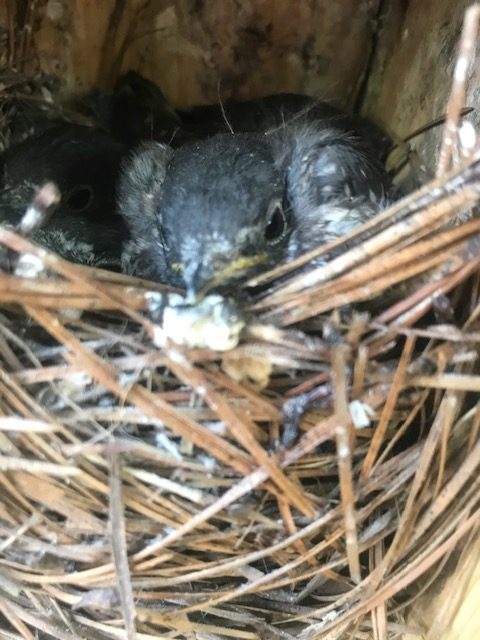
The Peace of Wild Things
Life in the Pandemic. It’s been a surreal month. We’ve run the gamut of emotions here at our house.
As good medicine we’ve been trying to cultivate an atmosphere of fun and silliness, starting with a Christmas tree decorating party our first week at home. 
Later we pulled out our giant inflatable Mickey Mouse. Last week it was chalk drawings on the side of our brick house.
Our backyard has become a campground. We started by setting up our tent on top of tthe hill overlooking the pond and invited Levi’s best friend R. over for a sleepover.
That afternoon we dug a dakota fire pit and I showed the boys how to build a fire from tiny little twigs. When the sun went down we made s’mores.
We’ve kept the tent up. Wonderfully enough, our tent-wi fi is excellent so I have been able to spend some mornings sitting in the tent answering work e-mails and listening to the frogs. They don’t seem to be afraid of us as evidenced by one who crawled into the tent to hang out with us.
It’s been a beautiful spring and things are in bloom in the back yard: Solomon’s Seal, Star of Bethlehem, paw paw flowers. Pretty yellow irisies and purple comfrey flowers. We have a blueberry bush that has grown seven feet tall and is sagging with tiny budding berries. In the bog, the pitcher plants are having little babies.
 Our yard is kind of sprawling and messy right now, though. I suggested to Levi that if we worked just a little bit in the yard every day, we could get some things accomplished. He liked the idea and now his favorite thing is to water the plants, whether they need it or not.
Our yard is kind of sprawling and messy right now, though. I suggested to Levi that if we worked just a little bit in the yard every day, we could get some things accomplished. He liked the idea and now his favorite thing is to water the plants, whether they need it or not.
in addition to the backyard time, there have been frequent walks to the Beaver Marsh, one of Ellerbe Creek Watershed Association’s nature preserves (all of which are still open to the public.) A 34-acre urban oasis and a short walk from our house, it is teeming with life right now. We’ve seen herons, baby ducks, and hundreds of tiny little frogs jumping to and from the shore. Once we saw a beaver jumping from the lodge into the water. Most days we don’t see any other human beings in the marsh. it’s just us and the birds and the beavers.
It has meant so much to connect with nature during the time of Covid-19. As always, it brings great comfort and joy. I noticed the ECWA folks had Wendell Berry’s poem “The Peace of Wild Things” posted on their Facebook Page which hits home right now:
When despair for the world grows in me
and I wake in the night at the least sound
in fear of what my life and my children’s lives may be,
I go and lie down where the wood drake
rests in his beauty on the water, and the great heron feeds.
I come into the peace of wild things
who do not tax their lives with forethought
of grief. I come into the presence of still water.
And I feel above me the day-blind stars
waiting with their light. For a time
I rest in the grace of the world, and am free.
Where the Frogs Went
Lately we’ve seen cooler temperatures with periodic bursts of rain, filling up Farthing Pond and our big rain cubes. Last week I estimated that we had about 2,000 gallons of water at our disposal, so when Levi told me he wanted to “build some waterfalls” I was happy to oblige. I just let the water run from one of the 275-gallon cubes. Levi yanked the hose from me and started piling rocks and other debris on the sidewalk, joyfully watching the water trickle down the front of the yard.
After a while he started getting more creative, diverting the water flow through some old pvc pipe and letting it fill up an empty pond shell I had lying around.
It got interesting when he discovered that he could make his garden pinwheels turn if he directed the water flow towards them. It seemed like a perfect time to talk to him about the merits of turbines and hydropower. I told him he’d made an important discovery.
Feeling inspired, we turned our attention to Farthing Pond. What if we “made” a waterfall, or at least the appearance of one, trickling down from the pond? It would be a nice visual. And so we began pulling up large rocks and digging into the ground in front of the pond.
On this day the temperatures were much cooler. Levi asked me what the frogs of Farthing Pond did in the winter. I explained to him that frogs are cold-blooded, their body temperatures taking on the temperature of the environment around them. During the winter, they go into a state of hibernation, and some can be exposed to temperatures below freezing. I told him I thought they might be hanging out at the bottom of the pond, in the muck and the mire.
Minutes later, as I was pulling up a big rock to make room for our waterfall, I uncovered one of our beloved frogs. “He’s alive, and in perfect hibernation!” I yelled excitedly.
We just stared at him in amazement for a few minutes. “Looks like they love to burrow,” I told him. After that we decided not to unearth any more rocks. Let sleeping frogs lie.
The Pump Station Trail
This weekend Levi and I took advantage of the beautiful weather and took a hike and picnic on the Eno river. Our destination was the old pump station, which supplied water for the town of Durham from 1884 to 1926.
We stumbled across the old ruins as if we were in some enchanted forest.
We spent the rest of the afternoon playing in the river, skipping stones and looking for artifacts and enjoying the sounds of nature. For a while we were the only two in the forest, and magic was in the air.
Spider Lilies
I recently read the excellent book 1491: New Revelations of the Americas before Columbus by Charles Mann. An overriding theme of this book is that pre-Columbian inhabitants of the Americas shaped their environment to fit their needs, time and time again. Some of these environments were barren intially but the land inhabitants were able to cultivate them with remarkable success. He sites, for example the terra preta of the Amazon Basin. This anthropogenic soil was made by adding a mixture of charcoal, bone, broken pottery, compost and manure to the otherwise relatively infertile Amazonian soil. The soil’s charcoal has remained in the soil for thousands of years.
I was thinking about the book when I stepped out of the house today. The backyard has become wild and overgrown due to my inability to tend to it this summer. In addition to the long grass there are beautiful red spider lilies popping up all over.
These flowers usually bloom around the autumnal equinox and apparently are bulb-producing perennials which likely means someone planted them before I bought the house.
Looking back it was the backyard that sold me on the house. A large, skinny double lot in the city, I noticed the rich, dark, earthy soil in the back which seemed anomalous considering most of the soil in the Triangle is red clay.
I asked my geologist friend Brian if our soil was rich due to some geological feature. He told me that it wasn’t, that it was more likely the yard had been cultivated by previous owners. He paused for a second and said “but if that’s not the case then it could be a burial mound.” Startled for a minute, I remembered that one of our elderly neighbors told me that back in the day, our yard was a giant sweet potato field. I started thinking about the lot’s previous owners and how long it had been cultivated. Hundreds of years? Thousands of years?
We continue the tradition by composting what we can and giving much love to our beautiful back yard. We plan on spending the next couple of weeks taming the yard back in shape. But we won’t mow over any of the beautiful spider lilies.
1979
Last Saturday I took Levi up to Gramma and Grampa’s place in Watauga County, NC, otherwise known as “Mielke Mountain.” At 4,000 feet, the temperatures are usually 12-15 degrees cooler than Durham. It was wonderful to escape the oppressive heat for a little while.
This time we didn’t bring our tent, due to the presence of two black bears on the property. A couple of nights before, one of the bears decided it would be fun to visit the front porch and eat some birdseed out of one of Gramma Sue’s feeders. Unfortunately, bear habitat destruction and a rebounding black bear population in the area means we are seeing more of them.
Gramma Sue was a little freaked out about us romping around the 12-acre property with the bears so close by. Since we forgot to bring our bear bells, she hooked us up with some cow bells from my great grandfather’s village in Switzerland. How fitting, since the flag of the Canton Bern is the bear!
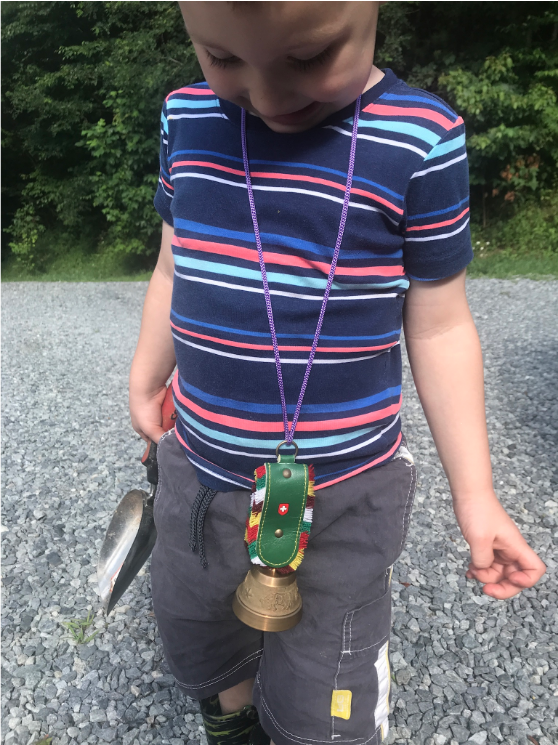 As we played, I was filled with immense gratitude for having grown up in one of the most beautiful places in the country. It was wonderful having the opportunity to share some of those same childhood experiences in nature with my own son.
As we played, I was filled with immense gratitude for having grown up in one of the most beautiful places in the country. It was wonderful having the opportunity to share some of those same childhood experiences in nature with my own son.
Our first day there we headed down to the creek to see if the dam we built last summer was holding. There it was, still intact, holding back a nice pool of water—and some crawdads had moved in. I told Levi we’d created a crawdad hole and showed him how to pick up a crawdad without getting pinched. His excitement was contagious and I just had to get it on video.
We also found several large salamanders–too elusive for us to catch or photograph. I was glad to see them, as it seems there are fewer of them than in the past. North Carolina has over 60 species of them.
We woke up one morning to a beautiful scene of cloud-draped mountains. Levi exclaimed, “The clouds fell on the mountains.”
The whole week I’d been thinking about that wonderful summer of 1979, 40 years ago, in Boone, NC. Those beautiful, sometimes foggy summer mornings where you needed a light jacket, at least for the first hour of the day. Days spent swinging on grapevines, catching salamanders, picking wildflowers. A more innocent time for sure. Our town seemed like a small village back then. That summer, when, for a brief period of time our little town was in the national spotlight after the world’s largest windmill, built on Howard’s Knob, was completed.
How fun it was to relive some of those experiences.
Mercy me, the fecundity
Spring is here, and the backyard is teeming with life. Everything is growing, budding, sprouting. The frogs have returned and the fish make regular appearances now. What could make us happier, other than the baby boy who will grace our doorstep any day now? I’m sure the stork will fly over our pond and eat a frog or a couple of goldfish on his flight back from our house. Everyone else does.
 Shawnna and I have been laughing a lot and using the word fecund to describe everything. It’s one of those words I remember from the SAT. The word comes from from the French word fecond (“fruitful”) and from Latin fecundus, (“fruitful, fertile, productive; rich, abundant.”)
Shawnna and I have been laughing a lot and using the word fecund to describe everything. It’s one of those words I remember from the SAT. The word comes from from the French word fecond (“fruitful”) and from Latin fecundus, (“fruitful, fertile, productive; rich, abundant.”)
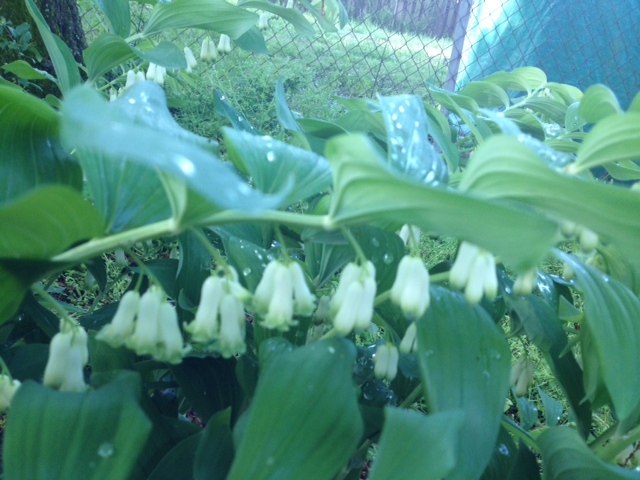 The yard has never looked more fecund as it does at this moment. I think a lot of it has to do with the fact that we are capturing and using more rainwater than ever before.
The yard has never looked more fecund as it does at this moment. I think a lot of it has to do with the fact that we are capturing and using more rainwater than ever before.
For example, in the very back of the yard near our paw paw patch, I dug a big trench, which gives the appearance of a fake stream bed feeding into the pond. It gets filled with water that would otherwise trickle down the yard and into the street. The paw paws, being river trees, seem to love the extra water.
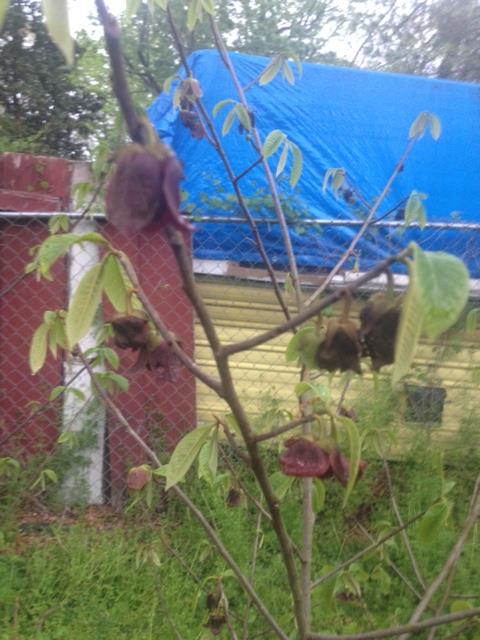 We are also using drip irrigation for the first time, and I believe this is making a huge impact. We have hoses attached to our rain barrels, which are placed under every downspout. Some of the hoses have holes punched in them so they will drip like a soaker hose. For others, we’ve just let a slow steady trickle come out of one end.
We are also using drip irrigation for the first time, and I believe this is making a huge impact. We have hoses attached to our rain barrels, which are placed under every downspout. Some of the hoses have holes punched in them so they will drip like a soaker hose. For others, we’ve just let a slow steady trickle come out of one end.
We have a hose dedicated for the strawberry patch.
We’ve planted some beautiful comfrey around the strawberries, which are providing a natural source of nitrogen for the strawberries. Some of the leaves of the strawberry plants have now gotten as big as the palm of my hand.
For the first time our pitcher plants are producing flowers that are at once both strange and beautiful.
The ferns are opening back up. They remind me of tiny seahorses.
 I thought I was a little crazy when I bought all those barrels and built a large pond in the backyard, but I think I had the right idea. Now we have about 2,000 gallons of water at our disposal. I’ve been amazed at how much our yard can use. And, with the drip irrigation, we can spend less time watering our yard and more time playing with our new arrival. Of course, he’ll be helping out on the homestead as soon as he’s able.
I thought I was a little crazy when I bought all those barrels and built a large pond in the backyard, but I think I had the right idea. Now we have about 2,000 gallons of water at our disposal. I’ve been amazed at how much our yard can use. And, with the drip irrigation, we can spend less time watering our yard and more time playing with our new arrival. Of course, he’ll be helping out on the homestead as soon as he’s able.
Birches
Nature is my first love and main source of inspiration. Lately I’ve been trying to express this in paintings. Bored with watercolors, I recently decided to give encaustic painting a try. This is an ancient form of art using hot melted wax with added pigments, and has a very interesting history. The ancient Greeks used beeswax to seal their warships, and it was only a matter of time before they started painting fancy portraits. Check out the Fayum Mummy Potraits from Greco-Roman Egypt. It was a relatively obscure medium until Jasper Johns repopularized it in the 20th century.
This weekend I attended an excellent encaustic workshop at the Durham Arts Council. We spent the first couple of hours learning the ins and outs of encaustic painting. Working off hot pancake griddles, we dipped our brushes in cans of melted beeswax and slopped the first coat on our canvases. For each layer of wax that we applied, we had to fuse it to the canvas using small blowtorches. I mixed the wax with the special encaustic paints right on the griddle. One of the biggest challenges is that the wax tends to harden as soon as it hits the canvas.
I knew exactly what nature scene I had in mind: a forest of birch trees in the snow. Lately I’ve been obssesed with birches. I’m sure Robert Frost would approve. I knew this painting would fit nicely in the jewel-tone blue of our living room. By the end of the day I was pleased with the results.
I realized this was a perfect medium for my nature portraits. The colors were more vibrant than those in my watercolor paintings. The wax layering created an amazing sense of texture too. I had lots of fun creating the dark horizontal lines you always see on birch trees, also known as lenticels. For this, I took an engraving tool and cut right down to the canvas, filling the grooved lines with black ink.
What to paint next?
City of Comfrey, Part 1
Listen up gardeners, it’s time to talk about the miracle plant, comfrey.
The plant, which has pretty pink or purple blossoms depending on the species, was called knitbone for thousands of years because of its ability to speed the healing of bone injuries. The ancient Greek historian Herodatus wrote about it, and it’s very name, symphytum, comes from the Greek symphyo which means to “make grow together.” In addition to healing fractures, the plant can been used to treat abrasions, skin irritations, insect bites and inflammation associated with rheumatoid arthritis. I’ve heard of people rubbing their arms and legs with comfrey leaves before working out in the garden. The secret ingredient is allantoin, which lives in both the leaves and the roots of the plant.
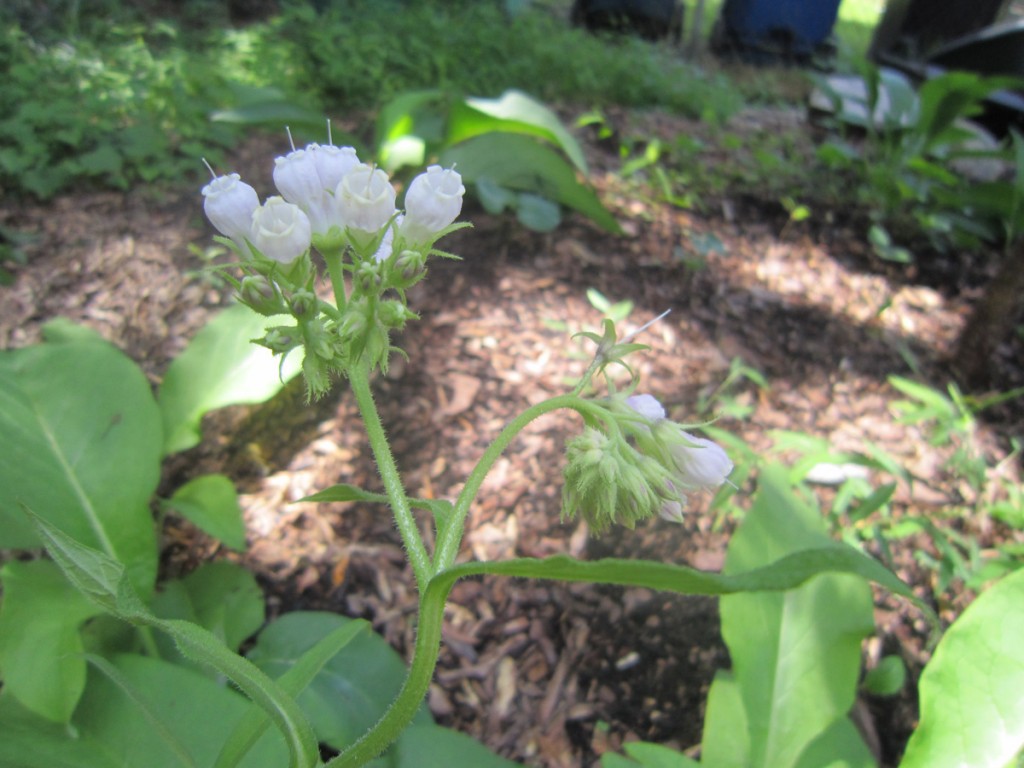 In the garden, comfrey can be grown as a living mulch. That’s because the plant is a root accumulator, sucking up nutrients into its roots and leaves. Hearing about orchardists who plant comfrey around their fruit trees, I decided to plant ring of it around our plum tree this summer. Not only does it fertilize the tree now, but it keeps the weeds out, and the bees love the pretty purple flowers.
In the garden, comfrey can be grown as a living mulch. That’s because the plant is a root accumulator, sucking up nutrients into its roots and leaves. Hearing about orchardists who plant comfrey around their fruit trees, I decided to plant ring of it around our plum tree this summer. Not only does it fertilize the tree now, but it keeps the weeds out, and the bees love the pretty purple flowers.
Because the leaves contain minerals like potassium, calcium, and magnesium, they make a great fertilizer. Our potassium-hungry tomato plants especially enjoy a liquid fertilizer mix of comfrey leaves and water. We create this mixture by putting the leaves in our watering can, filling it with water and then letting it soak for a while.
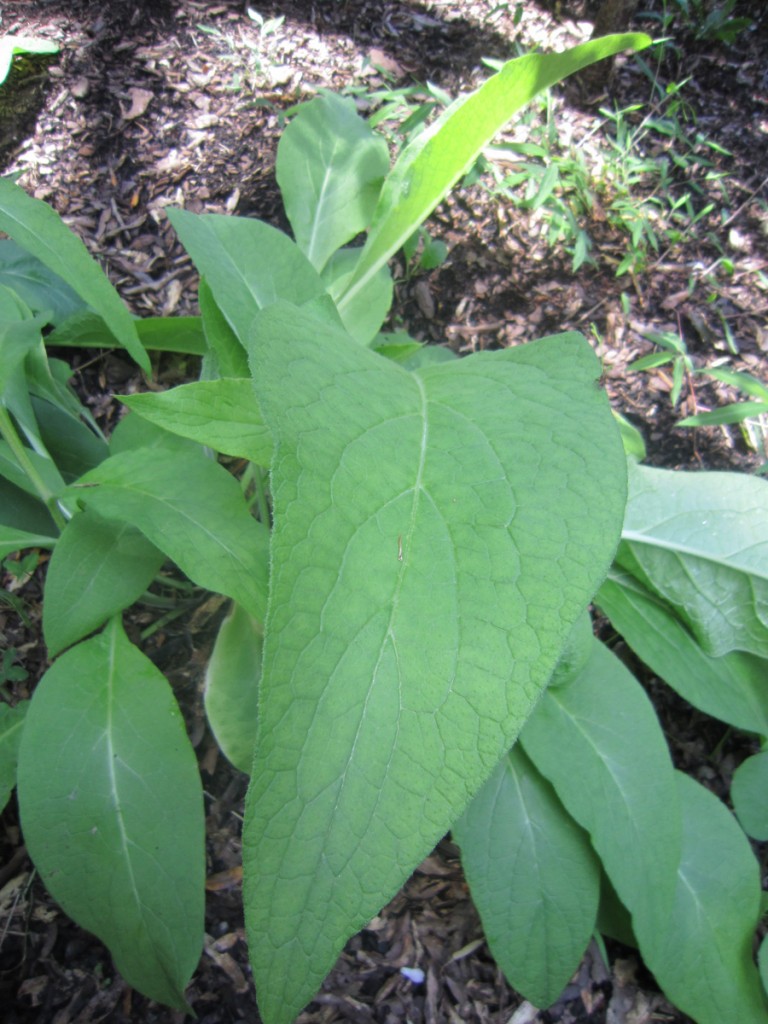 Some of you might be smitten now, thinking Comfrey, where have you been all my life?
Some of you might be smitten now, thinking Comfrey, where have you been all my life?
To those of you, heed this stern warning: comfrey grows very aggressively. I’ve been astounded at how quickly the comfrey patch has grown up around our plum tree.
I pictured it filling up our whole yard, then spilling out into the neighborhood and spreading across Durham. It wouldn’t be the worst thing in the world. My legs get itchy riding my bike on the greenway, so having comfrey leaves available to me on the trail would be an added luxury.
Durham could then become the city of comfrey. Suddenly Tupac Shakur popped into my head…..In the citaaay, the city of Comfrey. This could be a really great track to perform next year at the Durham Hip-hop Summit. I’ll need to work on my flow, though.
Please stay tuned for part 2. I’m now working feverishly in the basement, like Grandpa Munster, to come up with a comfrey ointment. This could be big at the farmer’s market.
Bear invades campus
A black bear decided to visit Duke this week. Seriously, the bear took a stroll over to the VA on Monday, getting as far as the parking lot before darting back to the woods across from Erwin Road. On Tuesday he was spotted over at the Center for Living. (I say “he” because most of these “city bears” are usually young males in transit, looking for a new territory to call their own.) Sometimes
they get turned around. Fortunately our friend was close to Duke Forest, where he should have some good cover while planning his next move. I wonder if he knows that Carolina is only 8 miles down the road. Nobody got a picture of the bear, so I’m using one of my stock images below.
I’m always surprised to hear about black bears in the Triangle, but I shouldn’t be. Traditionally our state’s bear populations have thrived in our western mountains and our eastern swamps, where there are large tracts of uninhabited land. From what I’ve read, their population has increased substantially over the last 40 years, thanks in large part to efforts by the NC Wildlife Resources Commission. Now they are living all over the place, and sightings have become more common as the humans have spread out into previously uninhabited spaces.
As fate would have it, my dad saw a bear crossing Clark’s Creek road near their house this morning. A tiny image, but check out those long legs. Time to get back up to the mountains.
Sweet potato pie (and shut my mouth)
I’ve had a sweet potato obsession for a number of years now. There is the occasional week where I’ll eat so many that my skin will turn orange. (Now that Syracuse is in the ACC, I’ll have to be careful not to look like Otto the Orange if I ever get to go to a UNC-Syracuse game. My head is fairly round.) My doctor reinforced this addiction when she told me during my last physical that I should substitute sweet potatoes for regular potatoes in my diet, as they are better for blood sugar. All I could do was turn my head and smile.
Naturally I bring this obsession to the garden. Over the last few years we’ve grown them, but I want to really maximize our yield in 2013. This year’s goal is to fill our root cellar with enough sweet potatoes to feed the entire block, or use them as a food source in case of a post-industrial collapse. Those things keep for over a year at a time. You laugh now, but some day, on the brink of starvation, you might be eating sweet potato fries from our solar oven.
The first step involved research. I knew that North Carolina leads the nation in sweet potato production with around 40% of the nation’s yield. Most of them are grown down east, in the land of vinegar BBQ. They aren’t hard to miss if you’re ever traveling east of I-95, where you’ll pass by enormous irrigated fields, green vines basking in the hot sun. This makes sense because the sweet potato is a tropical plant, indigenous to Central America. Lots of sun and water are essential.
The soil in our Triassic Basin region differs greatly from the soil down east, which is much sandier. This eastern soil, called Cecil Sandy Loam, is a dirt/sand mix with a layer of red clay on the bottom. With this in mind, I created a new sweet potato patch, using 40% leaf compost, 40% sand, and 20% red clay.
I mixed the compost and the sand together, and placed it on top of the clay. I also made sure the patch was deep and in a well-drained location. A couple of sources indicated that the soil should be at least a couple of feet deep, so I piled our sweet potato patch up to 30 inches.
Next we bought a few sweet potatoes at Whole Paycheck and then cut them into pieces, planting the sections that had “eyes” on them. It took a couple of weeks for the vines to start poking through. A month later, they seem to be doing nicely, unaffected (as far as we can tell) by the rot brought forth by last month’s deluge. Wish we could say the same thing about our tomatoes!
This weekend we’ll be fertilizing them some, using a fertilizer that has a higher concentration of potassium and phosphate with lower nitrogen levels. If you have too much nitrogen, the vines will grow abundantly, but the potatoes will be puny when you dig them up.
With sweet potatoes, the waiting is the hardest part. We like to give them 120 days to harvest, which means we’ll be harvesting in October. It’s so much fun digging them up with the shovel, although I always end up cutting open a few by mistake. After the harvest we have to let them cure in the cellar for a couple of months. They need this time to become sweet and luscious. That means they’ll be ready for Christmas. I look forward to stuffing one in Shawnna’s stocking.
The cinnamon bear
I’ve always felt drawn to black bears.
 Perhaps I am a human-ursine hybrid. Many people over the years have told me that I remind them of a bear. It’s true that I have a keen sense of smell and not the best eyesight in the world. And of course I’m always foraging for my next meal.
Perhaps I am a human-ursine hybrid. Many people over the years have told me that I remind them of a bear. It’s true that I have a keen sense of smell and not the best eyesight in the world. And of course I’m always foraging for my next meal.
Mind you, I only have this affinity for black bears, not grizzlies. Those things terrify me. I’ve seen Grizzly Man and I definitely wouldn’t want to become a wienerschnitzel platter for Mr. Chocolate.
I’ve always wanted to take a picture of one in the wild (from a comfortable distance of course.) Until that day, I have to be satisfied seeing them in captivity. Two of our favorite places to see black bears are the Museum of Life and Science in in Durham, and Grandfather Mountain in Linville.
The museum in Durham has a wonderful after-hours event for members called “Bears up Close.” For a small fee you get to tour the bear house and fling boxes of food for the bears to gobble up. The first time we went, a bear leapt up suddenly from nowhere and greeted us at the door.
The hair stood up on the back of my neck as my animal instincts kicked in. It’s probably a good thing I had the appropriate fight or flight response. Those nails looked long and sharp!
On our recent trip to Boone, we visited the bears at Grandfather Mountain. The bears seemed to be looking right at me, as if they had something to say.
I was smitten with the the beautiful cinnamon-colored bear on the right. Apparently only one percent of the black bear population have this coloration. Her beautiful coat glistened in the sun as she took notice of some frogs that swam up beside her. She seemed to be wary of them. Imagine that, I thought.
Suddenly I felt the inspiration to write a song about the cinnamon bear. A Neil Young parody, à la Weird Al Yankovic, popped into my head.
A dreamer of pictures
I run in the night
You see us together,
chasing the moonlight,
My cinnamon bear.
The cinnamon bear stayed with me for the drive back home to Durham. By the time I got back I was starving, but there was not a scrap in the kitchen. Famished, I did the only thing I could do at the moment: I went to the backyard to forage. To my delight, there were fresh figs waiting for me. And a few blueberries and blackberries too.
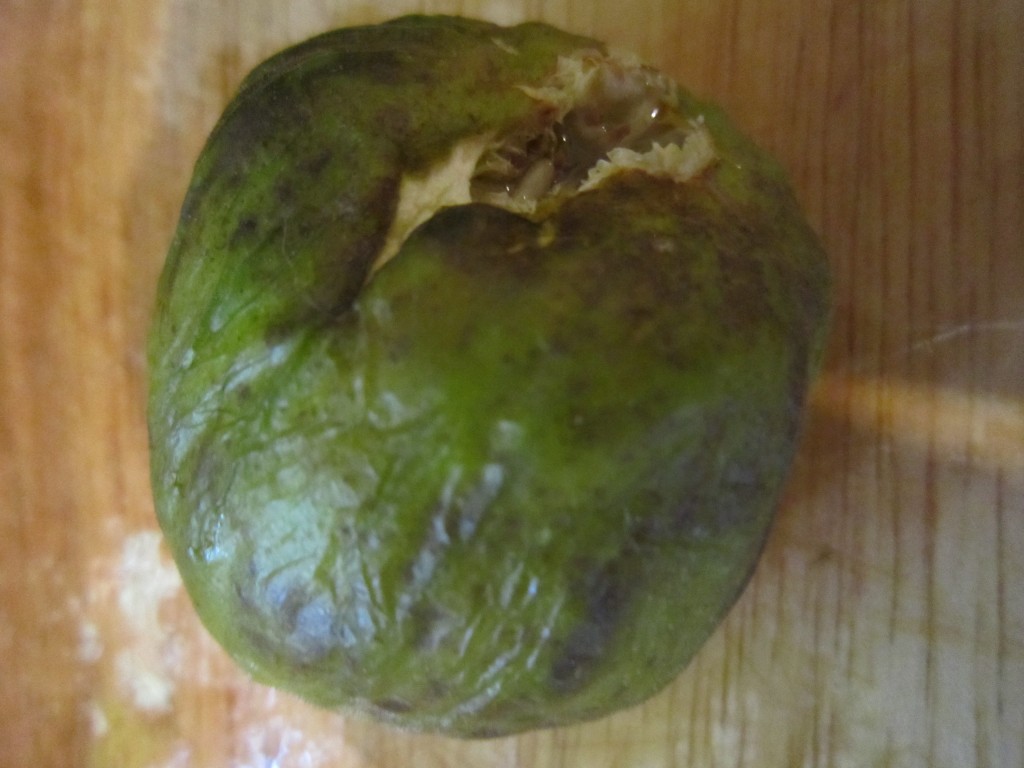 I stood up on my hind legs and spent the next half hour eating contentedly. Once I had gotten my fill, I lumbered back into the house and fell into a deep, peaceful sleep, dreaming of the cinnamon bear.
I stood up on my hind legs and spent the next half hour eating contentedly. Once I had gotten my fill, I lumbered back into the house and fell into a deep, peaceful sleep, dreaming of the cinnamon bear.
Pictures of Lily
Last year I thought it would be a good idea to get some lily pads for the frogs of Farthing Pond. What I actually bought were some hardy water lilies, which contain lily pads. This morning I noticed that one was getting ready to flower. By 10:00 a.m. it had opened up in all its glory.
Nothing today could have made me happier than this. Duke Gardens hosts the annual water lily contest every year which is sponsored by the International Waterlily and Watergardening Society. It’s always fun to see those lilies; never thought I’d see one as beautiful in our own backyard.
3 feet high and rising
Yesterday the rains came, completely submerging Northgate Park for a few hours until the water receded.
Kudos to our stormwater folks here in Durham; the fact that the water drained so quickly shows that all of their hard work and planning has paid off.
It was quite a sight to behold, and for a while I was thinking that they should invite the beavers over from the Ellerbe Creek Preserve and have them dam everything up. It would be lots of fun having a 17-acre lake or swamp only two blocks from the house.
Ellerbe Creek was raging; it was almost like being on the Haw River. I planned on getting my canoe out, until I saw a wicked current that could have sucked me under the bridge and spat me out on the other side. I decided it wasn’t worth the risk.
Back home, I had to pat myself on the back because the overflow from our pond was doing just what it was supposed to do.
I watched the water as it trickled down the side of our yard, into the driveway and down into the street.
All the swales in the backyard were completely swollen, and the bog we built for water overflow actually looked like a bog.
I shudder to think what could have happened to our basement yesterday had we not created the bioretention area in the backyard. In this era of climate destabilization, living a quarter of a mile from a floodplain tops my worry list.
I watched as water gushed down our street. Such a waste, I thought. I wish there was some way I could catch and store it. Who knows when we’ll have another drought…
Urban archery season
I read yesterday that Durham’s City Council is considering a measure to legalize bow-and-arrow deer hunting inside city limits.
From The Durham News article:
An ad hoc committee on curbing the deer population in Durham city and county has advised the city to allow bow hunting during the state deer season. It also recommends publicizing hunting regulations and
safety measures countywide, and encouraging hunters to donate deer meat to food pantries.
While I was reading this I couldn’t help thinking of what it would be like to walk down Main Street with a crossbow. Could you imagine? Archery has already made a big comeback due to the success of the Hunger Games. Maybe Durham’s millennials, inspired by the movie and the ecological benefits of controlled hunting, will start a local archery association. Better yet, it could evolve into a citizen’s militia which would defend Durham from invasions. That worked for the Swiss against the French, I believe. Time to listen to the William Tell Overture...
In all seriousness, though, I do like the idea of controlled hunting in Durham, and am intrigued by the added potential to feed our city’s poor. The rampant rise of North Carolina’s deer population over the last 20 years, a byproduct of suburbanization, has caused more tick-borne infections and car fatalities every year. Not to mention the thousands of dollars of damage to yards and gardens every year.
Our state already sanctions an “Urban Archery Season” that runs five weeks in the winter. According the the article, thirty-eight municipalities held Urban Archery Seasons 2013, but the Durham committee members working with the city council had advised against Durham joining them right away. (Chapel Hill, Pittsboro, and Wake Forrest already have already approved Urban Archery Season.) Any municipalities interested in participating must submit a letter of intent to the state’s Wildlife Resources Commission by April 1 of each year, complete with a map defining the area where hunting is allowed.
I’m not sure what the concerns are about bow hunting. I’ve been looking for stories on bow-and-arrow deaths in North Carolina, but wasn’t able to find any. On the other hand, there plenty of stories about the rise of deer-related car accidents.



















